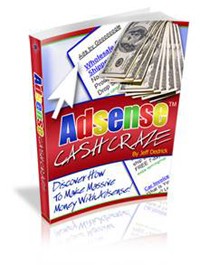 License Type: Master Resell Rights
License Type: Master Resell Rights  File Size: 493 KB
File Size: 493 KB File Type: ZIP
File Type: ZIP
 SKU: 24859
SKU: 24859  Shipping: Online Download
Shipping: Online Download
Ebook Sample Content Preview:
Part 2: The 5-Step Plan to Success
Once you’re accepted, you want to maximize the opportunity. In this section, we look at some of the most effective strategies for generating optimum revenue from the Google AdSense program.
Step 1 - Formatting Ad Blocks
You can let Google decide for you the type of ads that will be displayed on your webpage, but as the website publisher, you may be in a better position to decide what ads suit the content of your website and how you would like them displayed. To the extent possible, whether chosen by Google or you, make the ads seem like part of the site itself.
Most internet marketing experts believe that the ads on your website have a high probability of getting clicked if they blend in with the rest of the content of your web page. Factors such as color scheme, font size and type, and the appearance of your ad should match your web page. Borders are optional and we think you should often opt out. Why put a box around the ad that says, “Hi! I’m an ad!”?
Also, regardless of other design choices, text links should be blue. Why are text links blue? For the same reason Henry Ford said of the Model-T, “They can have any color they want so long as it’s black.” They just are.
Though we think text ads are generally better than graphic ads, also known as image ads, Google does offer them with the program.
Actually, you don’t need to struggle much with whether graphic ads or text will be better on your pages, as Google’s technology will suggest whether an image ad or a text ad will be more suitable and which will earn you maximum revenues (since you earn part of what they earn, they have motives to get this mix right).
However, it remains totally up to you whether you wish to run image ads or text-based ads. You can select only image ads, or text ads or a combination of both of these formats on your entire AdSense account or on one page at a time based on your discretion.
Step 2 - Ad Placement
“Location, location, location.” It is true in real estate and true in advertising, including web advertising. Since the “location” of the user is your site already, the “location” of the ad in this context means on which pages, where on the pages, and so on. As noted, the less an ad looks like an ad, the more effective it is likely to be.
Then there are general design and usability factors to consider.
If your webpage is cluttered and you can’t dispense with any content, you may want to break it down further into sections or more pages to provide easier reading. This also gives you the potential benefit of placing additional ads.
As noted, we generally recommend text-based ads. However, text-dense sites may actually do better with image ads. If your site has very few graphics, you may want to balance it out by putting image-based ads. In the monotony of a lot of dense written information, image-based ads and graphics provide what’s called visual relief. This can also prompt clicks.
Where should you put the ads? The chances of your ad getting noticed by the visitors to your site increases greatly if you place ads as close to the top of your webpage as possible.
If you choose to place so-called ‘skyscraper’ ads - in magazines these would be called columns - on the sidebars of your webpage, it would be wise to place them on the right side of your principal content areas. The reason for this is the visitor to your page (in most languages) will read from left to right. He or she will chance upon the ad ultimately, if not consciously, then at least out of habit. Their eyes will go there. From the left, they can visually “skip” the ad when they start reading next to it.
Your ads should be placed in such a way that it matches the links to other websites on your site. If you already have a links section on your site, put the AdSense links in that section or list. This is not dishonest - if it were, Google would not allow it.
Obviously if you have a “most popular” area on your website, such as a page that is updated daily with some kind of material that people bookmark to revisit often, place your ad(s) there instead of somewhere else that may get less traffic. For many websites the home page is not actually the most accessed area. If you don’t know what the traffic pattern is on your sites, it’s easy to find out - ask your hosting provider about usage logs.
One more thing: While some affiliate marketing programs encourage host sites to encourage clicks directly, it is not appropriate to expressly ask your readers to click on the ads served by the Google programs. Not only is it unprofessional and arguably unethical, it also annoys people and moreover Google AdSense actually prohibits any such activity. You can neither directly solicit clicks nor can you do anything considered deceptive to encourage clicks.
In conclusion, the emphasis is always on quality of content on your web pages. Good and interesting content makes your site better, more acceptable to Google, more likely to win with AdSense, and therefore more profitable for you!
Step 3 - Researching Keywords
After you are done choosing the right format and location for your AdSense ads, don’t sit back and wait for the money to roll in just yet. The next important step is to choose the right keywords for your web pages. These will influence both who visits your site, and how AdSense assigns ads to you.
The number one mistake most website publishers make is to constantly choose high-paying (i.e. expensive!) keywords assuming that it will yield them more income. While it is tempting to choose such keywords to get higher rankings on search engines, be prudent when it comes to selecting the right keywords that go with the AdSense ads that are to be displayed.. Remember the goal here is clicks, not SEO rankings. This is a case where you often do not get what you pay for.
- File Size:493 KB
- License: Master Resell Rights
- Category:Ebooks
- Tags:2008 Ebooks Master Resale Rights








